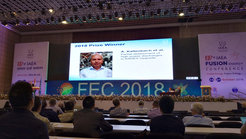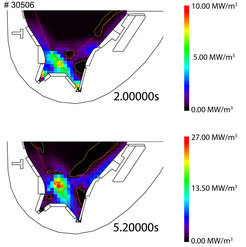Nuclear Fusion Award 2018 to IPP scientist
Arne Kallenbach honoured for wall-protecting experiments with high power plasma
The Nuclear Fusion Award 2018 is honouring Professor Dr. Arne Kallenbach of Max Planck Institute for Plasma Physics (IPP) at Garching.

Thus, for the second year in a row, an IPP scientist has been awarded this distinction. The annual award honours outstanding works published in the "Nuclear Fusion” journal, the most cited journal in fusion research. The award is presented to authors whose publications have had the most significant influence in the two years following publication.
Arne Kallenbach received the 2018 Nuclear Fusion Award for his 2015 work on high-power plasma experiments in Garching’s ASDEX Upgrade tokamak: "Partial detachment of high power discharges in ASDEX Upgrade". In his paper, Arne Kallenbach and the ASDEX Upgrade team investigated how to protect the divertor zone at the bottom of the plasma vessel, which is in contact with the hot plasma. The method involves transforming the direct contact into a mostly indirect one. This "detachment" is done by injecting precisely-dosed and feedback-controlled impurities, such as nitrogen, into the plasma edge. On their way to the divertor plates, the plasma particles lose most of their energy when colliding with the nitrogen particles before they finally hit the divertor plates. The nitrogen ions transmit the absorbed energy to the vessel walls in the form of light. While a partial detachment can be sufficient for ITER, a more “pronounced detachment” would be advantageous for fusion power plants.

Two-thirds of the power flux expected at the plasma boundary layer in the ITER fusion test reactor – amounting to 15 megawatts per meter, normalised to the plasma radius – can be simulated by the much smaller ASDEX Upgrade. Detachment could lower the load on the divertor from 45 to less than 2 megawatts per square meter. According to the laudation, "this important paper presenting results from the ASDEX-Upgrade tokamak shows that divertor detachment can be robustly controlled. This means that divertor target plates in machines such as ITER could have longer lifetimes. The work also, therefore, informs divertor design decisions for DEMO."
The 2,500 US dollars award was presented at the IAEA Fusion Energy Conference in October 2018 in Ahmedabad, India, and was accepted by the co-author Dr. Marco Wischmeier. Click here for the award-winning publication of Kallenbach et al..

